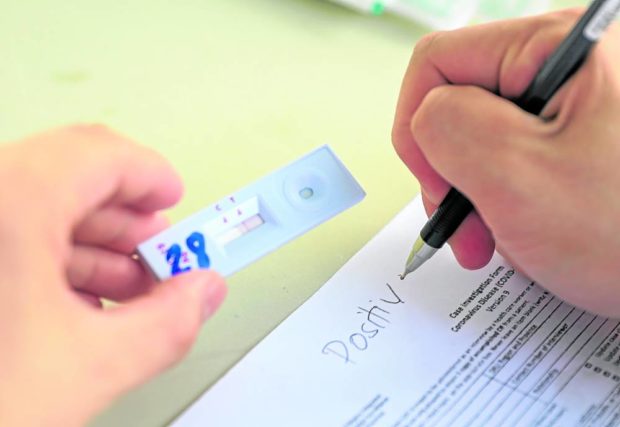Report COVID-19 antigen test ‘positives’ – DOH
MANILA, Philippines — The Department of Health (DOH) on Tuesday said the reporting of positive results of self-administered COVID-19 antigen tests is mandatory.
“All individuals with a positive self-antigen test shall report to their Barangay Health Emergency Response Team (BHERT) or healthcare provider,” the DOH said in Department Memorandum No. 2022-0033, the official guidelines on self-administered test kits.
In turn, the healthcare providers will report cases within 24 hours of detection by filling out a COVID-19 Case Investigation Form, which they will submit to their local Epidemiology and Surveillance Unit.
Local governments and telemedicine providers accredited by the DOH must put in place their own reporting system to facilitate the necessary local COVID-19 response upon detection of a positive case through self-testing, the DOH added.
Infectious waste
It also emphasized that used self-administered test kits are considered “infectious waste” and must be separated from other wastes and have a dedicated area or space during handling and collection.
The Food and Drug Administration (FDA) earlier approved two brands of self-administered antigen test kits: the Panbio COVID-19 Antigen Self-test of Abbott Laboratories Philippines, and the SARS-CoV-2 Antigen Rapid Test of Chinese company Labnovation Technologies Inc.
The DOH also stressed self-administered antigen testing is recommended only for symptomatic individuals within seven days from the onset of symptoms.
While the DOH allows public offices and private individuals to “procure, distribute or dispense” FDA-approved self-test kits “without need for a valid prescription,” it directed local governments to monitor their sale and use.
All manufacturers have been required to provide the instructional materials for buyers of COVID-19 self-test kits, including a step-by-step video guide for easy reference.
Drop-in cases
Meanwhile, OCTA Research fellow Guido David said the daily COVID-19 infections in the country could go down to 5,000 a day by the end of February and a resurgence in infections was unlikely.
He said cases have been going down in almost all areas in Luzon as well as in Cebu City, Tacloban, Iloilo, and Davao City, with only a few places — including Negros Oriental, Bukidnon, and parts of Cotabato — showing an acceleration of growth in cases.
“The projection for mid- to late-February in the entire Philippines is that cases will go down to less than 10,000. By late February, I’m expecting it could be close to just 5,000 cases per day,” he said at the Laging Handa briefing on Tuesday.

RETURN ENGAGEMENT: Workers on Tuesday dust off the movie ticket counter at SM Masinag in Antipolo City, Rizal province, one of the areas, including Metro Manila, that reverted to Alert Level 2 on Feb. 1 thanks to declining COVID-19 infections. (Photo by GRIG C. MONTEGRANDE / Philippine Daily Inquirer)
David said Metro Manila could be under low-risk classification in a week or two and OCTA was just waiting for the positivity rate to go down to less than 10 percent and for the average daily attack rate (Adar) to less than 10 before putting the region under this classification.
The positivity rate, or the percentage of positive cases out of the total tests conducted, stood at 17 percent in Metro Manila while the Adar (the proportion of people who fall ill in a given population) was at 19.58 percent, he said.
COVID-19 cases in the country have been dropping quite fast, David added, reiterating his earlier statement that the “worst is over” for many areas.
Back under 10,000
The DOH on Tuesday reported 9,493 new COVID-19 cases, the first time the tally fell below 10,000 since nearly a month ago and the lowest since Jan. 5 when 10,775 infections were reported.
But the new cases did not include figures from 10 laboratories that failed to submit data.
According to the DOH, these laboratories would have accounted for about 3,000 tests a day, with less than 1,000 COVID-19 positives.
COVID-19 intensive care beds in Metro Manila were 40-percent full (46 percent at the national level), isolation beds at 35 percent (45 percent nationwide), and ward beds at 40 percent (47 percent at the national level).
